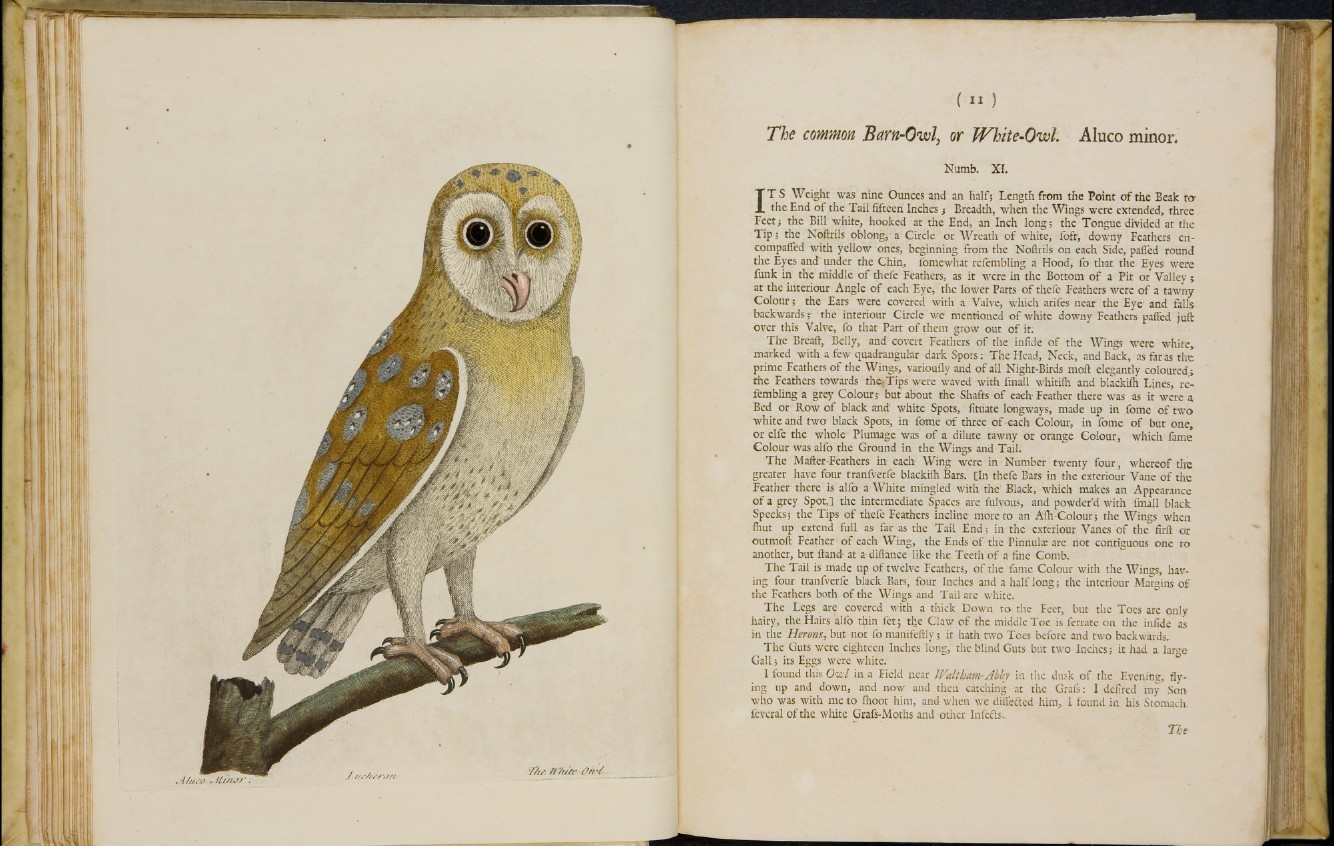
The common Barn-Owl, or JVhite-Qwl. Aluco minor.
Numb. XI.
IT S Weight was nine Ounces and an half; Length from the Point o f the Beak to-
the End o f the Tail fifteen Inches ; Breadth, when the Wings were extended, three
Feet; the Bill white, hooked at the End, an Inch long; the Tongue divided at the
T ip ; the Noftrils oblong; a Circle or Wreath o f white, loft, downy Feathers en-
compafled with yellow ones, beginning from the Noftrils on each Side, palled round
the Eyes and under the Chin, fomewhat refembling a Hood, lb that the Eyes were
funk in the middle o f thefe Feathers, as it were in the Bottom o f a Pit or Valley ;
at the interiour Angle o f each Eye, the lower Parts o f thefe Feathers were o f a tawny
Colour; the Ears were covered with a Valve, which arifes near the Eye' and falls
backwards; the interiour Circle we mentioned o f white downy Feathers palled juft
over this Valve, fo that Part o f them grow out o f it:
The Breaft, Belly, and covert Feathers o f the infide o f the Wings were white,,
marked with a few quadrangular dark Spots: The Head, Neck, and Back, as far as the
prime Feathers of the Wings, varioufly and o f all Night-Birds moll: elegantly coloured,;
the Feathers towards the*Tips were waved with fmail whitilh and blackilh Lines, refembling
a grey Colour,- but about the Shafts o f each-Feather there was as it were a
Bed or Row o f black and1 white Spots, fituate longways, made up in fome o f two
white and two black Spots, in fome o f three o f each Colour, in fome o f but one,
or elfe the whole Plumage was o f a dilute tawny or orange Colour, which fame
Colour was alfo the Ground in the Wings and Tail.
The Mafter-Feathers in each Wing were in Number twenty four, whereof the
greater have four tranfverfe blackilh Bars. [In thefe Bars in the exteriour Vane o f the
Feather there is alfo a White mingled with the Black, which makes an Appearance
o f a grey Spot,] the intermediate Spaces are fulvous, and powder’d with frnall black
Specks; the Tips o f thefe Feathers incline more to an Alh-Colour; the Wings when
fhut up extend full as far as the Tail End; in the exteriour Vanes o f the firft or
outmoft Feather o f each Wing, the Ends of the Pinnula: are not contiguous one to
another, but ftand at a diftanee like the Teeth o f a fine Comb.
The Tail is made up of twelve Feathers, of the fame Colour with the Wings, having
four tranfverfe black Bars, four Inches and a half long; the interiour Margins o f
the Feathers both of the Wings and Tail are white.
The Legs are covered with a thick Down to the Feet, but the Toes are only
hairy, the Hairs alfo thin let; the Claw o f the middle Toe is ferrate on the infide as
in the Heronsy but not fo manifeftly; it hath two Toes before and two backwards.
The Guts were eighteen Inches long, the blind Guts but two Inches; it had a. large
Gall; its Eggs were white.
I found this Owl in a Field near Waltham-Abby in the dusk o f the Evening, flying
up and down, and now and then catching at the Grals: I defired my Son
who was with me to ihoot him, and when we diffeäed him, I found in his Stomach,
feveral of die white Grafs-Moths and other Infeits..